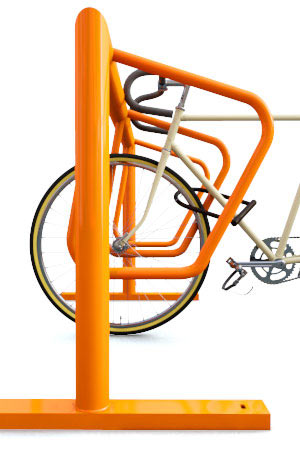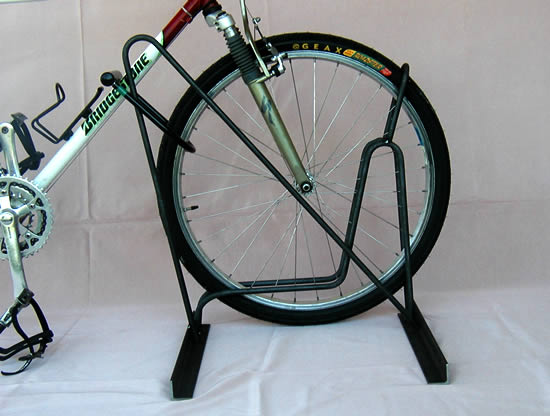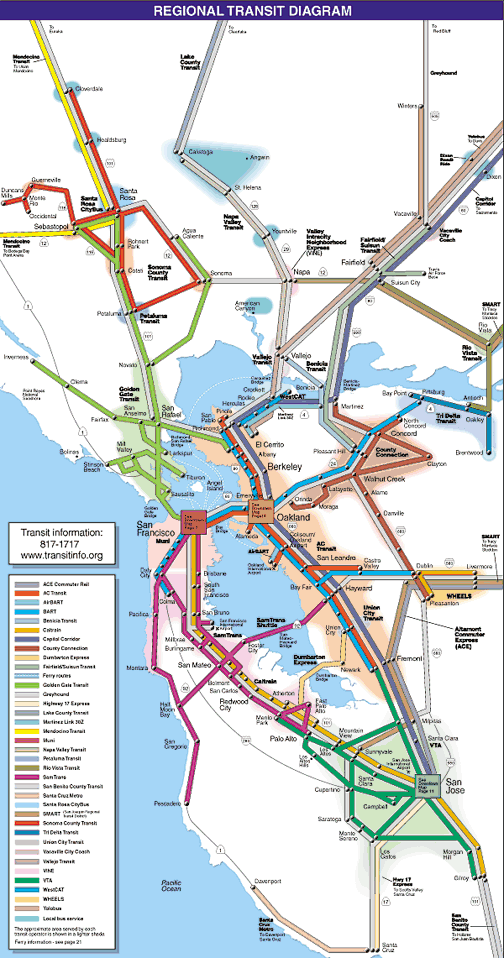Golden Gate Transit wants to get Larkspur Landing and the Bettini Transit Center in downtown San Rafael new bike racks and new signage, indicating the agency is serious about integrating its system with the region’s, and understands that burgeoning bicycle usage is good for business. The request for bids (PDF) went up on GGT’s website two weeks ago and, though it’s always questionable if there will be any acceptable bids, it’s an exciting development.
Bettini Bike Racks
The Transit Center has 41 bicycle parking spaces at the moment. Though at the edge of a rather bicycle-unfriendly district of the city, the spaces fill up often. Google Streetview shows bicycles locked to poles and signs, and I’ve seen more bikes locked to fences under the freeway. Clearly, there is a need.
In response, the transit agency wants to install 25 new spaces using Dero double-sided campus racks scattered around the platforms. It’s unfortunate that none of these racks will be covered. Bicycle handles and seats will bake in the summer and get soggy in the winter, which can mean an uncomfortable ride home after work. On the other hand, most bicyclists who don’t mind riding down Fourth Street – or, God forbid, those traffic sewers charitably known as Second and Third Streets – can probably deal with some heat or wet. Besides, the Transit Center was built without much regard for bicycle parking in the first place. There just isn’t a whole lot of space under the rooftops.
Larkspur Landing Bike Racks
Larkspur Landing has 71 bike parking spaces – 60 outside the fare-restricted waiting area and a paltry 11 inside. GGT wants to replace the planter boxes lining some of the waiting area with 56 new bicycle spaces. The racks will be Peak Racks' single-sided campus racks.
Given the crunch of access to Larkspur Landing, this makes a great deal of sense. For whatever reason, neither Marin Transit nor Golden Gate Transit have made Larkspur Landing bus service a priority, though this will change with the Greenbrae Interchange Project. Parking is at its limit, too, and unless there's space to either take bicycles to the city or lock them at the terminal people will choose to drive instead.
Signage
Both the Transit Center and Larkspur Landing are going to get new signage, and this is just as exciting as the bike racks. All signage will be in the style of MTC's regional transit hub signage initiative (PDF), meaning branding and stylistic consistency between Marin's major transportation hubs and those in San Francisco and the East Bay, putting our transit hubs on the same level as BART stations.
If the map suite will be the same as what we find in the East Bay (PDF), we can expect four displays. First is a station map, indicating what stops where. Though the Transit Center already has such a map, theirs is rather less intuitive or stylish than the MTC version. Second is the vicinity map, showing the streets, transit stops, and points of interest within a half-mile radius. These are typically found in kiosks in the City, and would be extremely useful down Fourth Street as well. Third is the local system map, showing where transit goes in about a two mile radius. Last is the service display, showing all services with fare information, timetables, transfer information, and the like. GGT wants to add a bicycle parking map, which will be in MTC's style though will be locally produced.
The drawback is that it seems like these signs won’t have their own internal lighting. The design documents show nothing about internal lighting or electrical systems. For those who are hard of seeing, this might be problematic. The Transit Center's internally-lit ad kiosks look great, and it's shameful that it's easier to see that you should buy Chanel than it is to see how to get home.
History and Cost
The project has been in the works since at least 2009 when the Bridge District applied for $245,000 in federal highway money through MTC. A $40,000 project was approved, but the project didn't get going until this year. Costs will be covered by FHWA if, of course, the bids that come in are acceptable, and that’s not a sure thing.
This is a move in the right direction for GGT. MTC has called on the agency to upgrade its signage and wayfinding to be in line with regional standards. Given the mediocre stuff currently on display – not to mention the moldy and cheap printouts you can find on display – this will move GGT out of the 1980s. Indeed, for the Transit Center it has been six years since MTC pushed GGT for change (PDF), so it's great to see the agency finally taking signage seriously.
With more people riding bicycles for everyday transportation, too, more racks will mean better transit access, and more parking, for those that need it. Bicycle use is exploding across the country, including Marin. By adapting to the times, GGT makes its transit infrastructure more flexible for the whole county.



